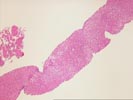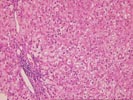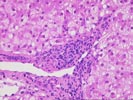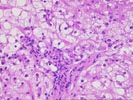Comment:
The changes in the bile ducts, including atrophy and focal
damage, together with the other portal findings raise the
possibility of a bile duct stricture or other form of biliary
obstruction, and this should be excluded, if clinically
indicated, by cholangiography or other means. Such changes may
also be an early indication of evolving chronic rejection,
although other features to support that diagnosis are not seen.
The history of HCV in conjunction with the hepatocyte swelling
also prompts consideration of a fibrosing cholestatic form of
recurrent Hepatitis C.
Previous Biopsies on this Patient:
None
TPIS Related Resources:
Liver Allograft Rejection Grading
Liver Transplant Topics




The liver biopsy shows intact hepatic architecture with slight fibrosis and expansion of the portal tracts. The portal tracts demonstrate atrophic bile ducts with loss in a rare portal tract. There is a mixed inflammatory infiltrate including neutrophils, focal lymphocytes and rare eosinophils. Subendothelial infiltration is not seen, and lymphocytic duct damage is not a prominent feature. The hepatocytes are swollen and there is foci of canalicular cholestasis with cholestatic rosetting of liver cells. Lobular inflammation is minimal other than an occasional neutrophil and a rare focal necrosis. No viral inclusions are identified and no central venulitis is seen.
Overall, the changes suggest an ongoing cholestatic process. Given the portal alterations, a bile duct problem should initially be excluded and the possibility of early chronic rejection or an evolving fibrosing cholestatic hepatitis C can also be considered.